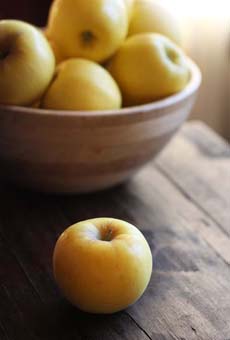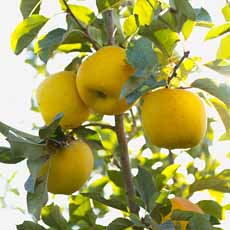TOP PICK OF THE WEEK: Opal Apples
 [1] Opal apples: golden beauties (both photos courtesy Golden Sun Marketing).
|
The most food excitement we’ve had recently in our house is…an apple. Not just any apple, but The Opal® apple, a relatively new breed that has finely made its way across the country. This exceptional, golden-skin apple (with touches of blush) is: It’s our new favorite apple-a-day. They’re available November through March, so we’ll be happy for a while. Here’s a store locator. For recipes and more, visit OpalApple.com. Use Opals as name cards for Thanksgiving dinner. Create name tags and attach them to the apples—which turns them into party favors. If you don’t use name cards, place a bowl of apples at the front door, so guests can take an apple with them upon departing. When they wake up the next morning and dig into their apple, they’ll have another reason to give thanks. Opal is the brand name for a cultivar of apple also known in the industry as UEB32642. It was created by crossing a Topaz apple with a Golden Delicious (let us hastily add that to us, the Golden Delicious seems to have contributed only its color, and not the bland qualities we associate with that particular cultivar). The breed was developed by the Institute of Experimental Botany in Prague, Czech Republic in 1999*. In North America, it is grown exclusively by Broetje Orchards in Washington, and marketed by the First Fruits company, a collaborative marketing company owned by growers. It has limited growers worldwide; currently Austria, France and the Netherlands. It was first introduced in 2010* in the Pacific Northwest, where it is grown by family-owned Broetje Orchards in Washington. The child of the Topaz was christened Opal, much more memorable than UEB32642. |
|
|
Opal Goes To Outer Space On January 10, 2015, the Opal embarked on a mission to outer space, on a delivery mission to the International Space Station aboard the SpaceX Falcon 9 rocket. NASA approached FirstFruits with the request. Because of the high cost of sending items into space, each crew member received only one or two apples…but no doubt have another to-eat item on their lists when they return. Opal Gives Back The Opal apple also gives back. Each Opal grower also commits to contributing a minimum of 10% of their profits to charitable causes. Broetje Orchard, the North American grower, donates 50% or more of their net profits to charities around the globe. The Opal Apple Youth Make a Difference Initiative was launched in 2013, awarding grants to youth-led non-profits focused on issues surrounding food security and politics, nutrition and agriculture. *It can take decades to develop a new cultivar of fruits and vegetables. The release date, 1999 for this cultivar, denotes when the new breed was ready for release, i.e., to be distributed to growers, who pay a royalty fee per tree planted. The developer (in this case, the Institute of Experimental Botany in Prague) can grant exclusive rights to one grower in a country or region; or can enable a wider distribution. As they create the new variety, growers wait years for trees to mature and bear fruit, and also to see how well the cultivar grows in their growing regions. In general, with new high density trellised planting techniques, apple trees will not produce fruit until they are between 3 and 4 years of age. It then takes an additional 7 to 8 years before the tree comes into full production. Once the trees bear successful fruit, the grower can then expand the acres cultivated…and wait more years until those trees bear fruit and come into full production. That’s why the rest of the country is only now getting shipments of the Opal apple. Opal apples currently are grown in the U.S., Chile and Europe (Austria, Belgium, England, France, Germany, Italy, Netherlands, Slovenia and Spain.
|
||




